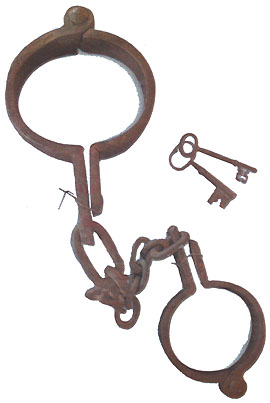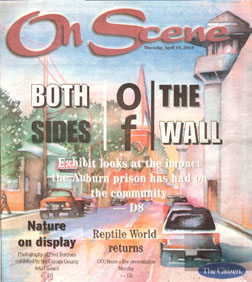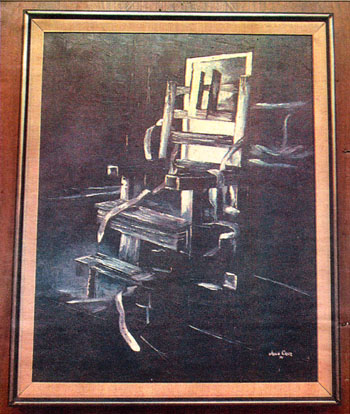![[NYCHS Shield]](../../images/nychshd6.gif)
![[museum logo]](../images/image002.gif) NYCHS reprint of NYCHS reprint of
The Citizen's feature article about the
Cayuga Museum's
Both Sides of the Wall: Auburn and Its Prison
exhibit on the eve of its opening reception.
NYCHS acknowledges and appreciates receiving permission to post on our site the text and images from The Citizen's OnScene article published April 10, 2003 on Pages D8, D9, and D15. All rights reserved to and retained by The Citizen.

JANE A. STEBBINS
Staff Writer
AUBURN
Visitors to Auburn often ask "why is there a prison in the middle of the city?" Newcomers find the prison's physical placement in the community odd but to native Auburnians, the Auburn Correctional Facility has been a looming presence and an integral part of Auburn since 1816. The prison and the city have had a symbiotic relationship, from
the day the first cornerstone was laid.
The Cayuga Museum examines the impact the prison has had on the community in an exhibit titled Both Sides of the Wall: Auburn and Its Prison.
 |
Old leg irons once used on prisoners are on display at the Cayuga Museum Both Sides of the Wall exhibit beginning April 12th. [Matthew Hinton, Staff Photographer.]
|
This exhibit displays prison memorabilia including more than 100 photographs, prisoner created furniture and art, doll furniture, restraining devices such as shackles, handcuffs, billy-clubs, and homemade weapons confiscated from the inmates. A full-size replica of a contemporary cell will also be exhibited.
"Auburn Prison is of national significance," Eileen McHugh said."This prison was a leader in national and international penal systems, it was the first prison to have individual cells, a chaplain on staff, house the criminally insane separately and the first to use electrocution."
"Until the late 1970s, there was a hobby shop in the prison where prisoners build a variety of wooden items and created paintings," McHugh said. "These programs no longer exist at the prison, but much of what they made is on display."
Guest Curator Juan Cruz, a former ACF inmate and professional artist is curating an inmate art show that is part of the larger exhibit opening May 18. Cruz studied painting during his incarceration at Auburn, and came to national attention through inmate art shows of the 1970s. After Cruz was released, he won a full scholarship to study art at Syracuse University.
EARLY PRISON ARTIFACTS
"Over 150 photos will be shown, and prison artifacts such as shackles, tap sticks and door locks and keys have never been seen by the general public. We also have the original bell that tolled during the evening hours," McHugh said.
"Prison artifacts are stored but not displayed in the prison," said ACF Superintendent John Burge.
"By loaning these items to the Cayuga Museum, the prison hopes the public will gain a greater insight into how Auburn Correctional Facility began, the changes it has gone through and where it is today. The prison impacts on the community on a daily basis, as we have almost 900 employees. The community needs to be aware that the prison is truly a city within a city."
EARLY PRISONER TREATMENT
McHugh credits John Miskell, former deputy at ACF for his in-depth research on the prison. Miskell wrote Why Auburn? The Relationship between Auburn and the Prison, and his work helped McHugh caption the photo exhibit.
"Confinement in prison began with the humane idea of treating criminals as human beings, not as animals," Miskell said. "Auburn Prison was, and continues to be, a model of how prisons should be run today."
Many of the exhibit's photographs clearly show how early prisoners were controlled.
John Cray, the creator of the statue "Copper John" that survived the riots of 1929 and continues to stand atop the new administration building, was also the developer of the "lockstep."
"The lockstep was a method of walking where each man walked with their arms locked under the man's arms in front of them," McHugh said. Photographs [show the] inmates in lockstep, where they were required to alternate which side they were looking, to discourage communication.
Both Sides of the Wall:
Auburn and Its Prison
Cayuga Museum 203 Genesee St., Auburn
April 12 through August 31, 2003
Museum hours: Tuesday through Friday 10 a.m. to 5 p.m., weekend noon to 5 p.m.
Information: 253-8051
On May 21, Peter Wisbey of the Seward House will speak on the many visitors who came to Auburn to tour the
prison for a fee. The Mayor's Social Justice Task Force will sponsor a series of public dialogues around contemporary
prison issues, and the museum is hosting an inmate art show to run concurrently with the exhibit from May 18
through June 29.
|
The prison developed a "silent system" that did not allow prisoners to speak at any time, day or night. No verbal communication of any sort was allowed. Guards didn't speak to prisoners either; they communicated through different tapping, using wooded staffs with metal ends. The guards tapped the sticks loudly and inmates moved according to
the number of taps taught to them.
"All the mess hall tables faced outward; no one was face to face then either," McHugh said. "Complete and total silence was strictly enforced. The punishment for speaking included flogging, the yoke, and the shower bath, where guards would cascade freezing water on naked prisoners who were fastened to wall shackles. At that time it was believed that prisoners possessed full time criminal tendencies, and only by strict regimen and routine could the soul
be cleansed and prisoners would learn to work hard."
"I've got 33 years in the prison system, and I can't imagine working under that kind of strict criteria," Burge said. "It's hard to understand, but back then maintaining prisoners was more of a military setting, more regimented. The silent
system would not work in today's prison system."
Another method used to subjugate prisoners was to shave their heads and clothe them in striped uniforms, stripping them of any identity. Every attempt was made to isolate a prisoner and keep him from speaking at all. These methods ended in 1910.
PHOTO ESSAYS
A 1909 photo essay of an unidentified prisoner entering and being processed at ACF will be displayed.
"This man's confinement in prison began with meeting the warden and chaplain, his measurements done by the prison doctor, and an introduction to other aspects of prison fife," McHugh said, describing the subject of the essay. "We have no record of why this series
was produced or if this man was actually a prisoner. The shots are clearly staged, and it is a possibility this photo essay was to inform the general public, but the pictures were
never published."
 | |
Front page of The Citizen OnScene section featuring the Cayuga Museum's "Both Sides of the Wall" brochure cover illustration by Cheryl Chalmers.
|
Later photographs display the Mutual Welfare League, created by Thomas Mott Osborne, Auburn
mayor, author of Within Prison Walls, and chairman of the state's prison reform commission.
The League was designed to allow prisoners a voice in prison affairs and was one of the first attempts at reform that ultimately failed. Osborne is shown posing and bringing prisoners
to country work farms called "Tom Brown" work camps. The name came from the name Osborne had
assumed when he secretly entered the prison as a convict in order to gain a prisoner's perception of incarceration.
"The inmates were happy to work at these farms," McHugh said. "Osborne stressed education over punishment Photos also show early prisoner classes. This is one of the
many ways the prison began running in a more humane way."
Another set of photographs [is] of traveling entertainers, including bands and theatrical troupes who performed in the prison.
"One photo of a vaudeville troupe of 'Little People' entertained prisoners from 1900-02 is a poignant reminder of the kinds of things people considered 'entertainment' in
that era," McHugh said.
THE LABOR COMPONENT
"The prison has been through many changes over the years," McHugh said. "Guards were called
'keepers,'and inmates began creating furniture for special guard occasions such as weddings and anniversaries, with much of the furniture made in walnut. A storage desk, created in 1872, boasts intricate wood mosaics; it's very ornate."
It was also at this time that Auburn businesses began utilizing prison labor to build their businesses. Auburn Prison utilized a contract system with private companies for forced prison labor. The state's goal was to have the prison not only self-supporting, but to turn a profit
Many of Auburn's early industries such as Dunn and McCarthy and Macintosh and Seymour began with cheap prison labor.
 | |
A 1974 painting by former prisoner Juan Cruz of the original electric chair at Auburn prison on display at the Cayuga Museum Both Sides of the Wall beginning April 12th. [Matthew Hinton, Staff Photographer.]
|
Using prison labor allowed private companies to amass huge fortunes. When the companies became financially solvent, they would move their businesses outside the prison and hire immigrant workers. Contract prison labor proved profitable from 1828 to 1851, with Auburn
Prison producing enough revenue to support itself and pay officer's salaries. At that time, prisoners were paid 27 cents per week and in 1879 inmates made 46 cents per week.
Inmates produced shoes, tools, furniture, barrels, sashes and blinds.
In 1890 contract labor was replaced by a state-use system at ACIF to reduce state expenses.
"Convict forced labor actually lead to the achievement of the American dream for immigrants who moved to Auburn in the early 1900s," McHugh said. "Though these immigrants worked in the
same horrible, unsafe conditions as the prisoners, they were able to save money, purchase a home and send their children to school. The prison had a profound effect on Auburn's economy and growth."
THE ELECTRIC CHAIR
Exhibits of various photographs and a Cruz painting of the electric
chair are exhibited. Auburn Prison was the first to use the electric
chair.
"A nine-minute video shot during the 1929 riots filmed by Auburn
filmmaker Theodore Case will also be shown," McHugh said.
"There is an enormous amount of history surrounding the prison,
and this exhibit presents its history to the average person in ways
they've never thought about before," McHugh said.
| ![[NYCHS Shield]](../../images/nychshd6.gif)
![[museum logo]](../images/image002.gif)



